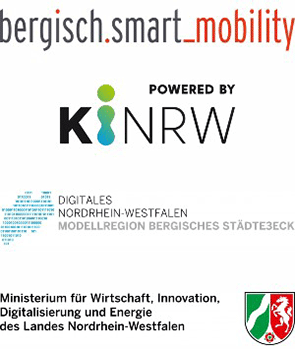Subproject 2:
SMART DRIVING IN THE QUARTER
Themed “Bergisch.Lab im Stadtteil”, various AI-based mobility concepts and technologies are to be tested under real conditions in this subproject.
In this subproject, a new public transport business model “On Demand Ride Hailing” and sensors and algorithms for highly automated/autonomous driving , which will be developed in another subproject, will be tested in Wuppertal. The related tasks will be carried out by APTIV Services Deutschland GmbH, Wuppertaler Stadtwerke (WSW Mobil GmbH) and Bergische Universität Wuppertal in work packages 1 to 4 of this subproject.
In addition, the Bergische Struktur- und Wirtschaftsförderungsgesellschaft mbH will focus on the effects of autonomous driving and AI-supported mobility on mobility concepts and urban planning (work package 5).
Data Centric Software
In the current automotive evolution from conventional combustion engines to electromobility, further technological innovations are emerging that are changing the classic understanding of the automobile. In this context, it is necessary to use the new networking possibilities offered by a Smart City for the efficient use of an automobile. In a Smart City, vehicles will in future be an integral part of the IoT (Internet of Things). An automated driving vehicle will have a mobile high performance computing platform with many sensors that give it a detailed picture of its environment. In addition, live information from the cloud will be used to extend the environment capture far beyond the range (time and space) of the vehicle sensors and to return information about the environment live into the Smart City Cloud. The following work packages are being processed for this purpose:
Software Defined Network in the vehicle environment (architectural design)
Dynamic integration of functions from sensors to the cloud
Implementation of Accelerator Agnostic Applications
Embedding of AI-based optimization methods in the software-defined car concept
Development of a software management system
Testing in the overall context
Advance Radar & Lidar Perceiption
Machine learning or artificial intelligence is a key technology for environment recognition in automated driving. Usually several sensors are used to detect the entire environment around the vehicle. These sensors are typically radar and lidar sensors. Until now, conventional tracking algorithms have been used to detect and track moving objects. However, these methods reach their limits with slowly moving objects or immovable targets. Aptiv is one of the market leaders among manufacturers in the field of automotive radar sensor technology and has the corresponding expertise in data evaluation. Aptiv and BUW will use machine learning and artificial intelligence to develop a new generation of sensor data processing to improve the perception of the vehicle environment:
Development of a database with reference data
Development of a training system for machine learning (pedestrian recognition, object recognition, etc.)
Development of lidar algorithms
Development of radar algorithms
Evaluation and documentation, including software-in-the-loop system (testing of the processing chain of the detection sensors used as a whole)
On Demand Ride Hailing Service & Acceptance Research
On Demand Ride Hailing Service (ODV) describes a new mobility service that provides people in a defined area with a free choice of starting point and end point without being tied to a specific line. ODV moves on the direct route between the two points. The exception is pooling. If one or more other persons want to move in a similar direction and book the service via the app, they are additionally collected so that the vehicle is used by several persons. Unlike a taxi, the vehicle is not rented, but only one seat. The procedure is as follows:
Structure of the ODV Infrastructure & Communication Concept
Training (drivers) and communication measures (population)
Trial operation in the quarter
acceptance research
Practical testing of autonomous driving technologies in the neighbourhood
In the cities of the Bergische Städtedreieck there are city quarters that differ from their topography, population, infrastructure, etc.. Some of the city quarters are (already for a long time) in a profound process of change or are at the beginning of such a process. It is assumed that the effects or possibilities of AI-based mobility differ depending on the individual conditions in individual urban districts.
Based on a desk research to collect the latest findings on the implementation of mobility concepts, interviews will be conducted with representatives of the city administration (urban and traffic planning), the municipal utilities (as possible providers of autonomous public transport) as well as citizens’ initiatives in order to record the actors’ specific views on the topic. The results will be documented and published in a report.
Based on the findings, project reports, workshops and individual discussions with the participating partners will be used to develop recommendations for the introduction of AI-based mobility and highly automated driving in urban districts. These are based on the developed strategic scenarios, infrastructure concepts and feasibility studies. Due to the different structures of these cities and their neighbourhoods, the recommendations for action can then also be applied to other cities in North Rhine-Westphalia and in all of Germany.



